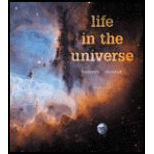
What is a habitable zone, and how is the idea useful? Is a planet in the habitable zone necessarily habitable? Explain.
The definition of the habitable zone with its usefulness and discuss the habitability of the planets belonging to the same habitable zone.
Answer to Problem 1RQ
Habitable zones are the area around the central star which has an possiblity of supporting life. Every planet present in an habitable zone does not neseccarily support life as there are various other factors which are required for life to exist on a planet.
Explanation of Solution
Habitable zone is an area around a particular star i.e. the orbital region which has an ability to support different forms of life. The sustenance of life on a particular planet is determined by presence of the various life supporting matters such as water, oxygen, carbon dioxide etc. The planets belonging to the same habitable zone has a higher possibility of life sustenance as the conditions they are exposed to is similar.
All the planets present in a habitable zone does not necessarily support life because there are various other factors which is helpful to determine the habitability of the planet. Factors which are necessary to support life on a planet is as given below.
Luminosity- It is defined as the brightness of the planet in other words the temperature on the planet.
If the solar system in which the sun is the central star is considered, the luminosity of the planets can be determined by the distance of the planets from the sun.
To maintain an optimum temperature the planet need to be in a region which is neither too close to the sun nor too far. Closeness to the sun makes the planet hotter and the distant planets are at very lower temperature. Thus luminosity which can be determined by the distance from the sun plays an important role in sustenance of life.
Size of planet- Except the distance of the planet from the central star, its size plays an important role to sustain life. The planet needs to be large enough to retain heat and to bear plate tectonics to regulate the climate.
Atmospheric conditions- The atmosphere on the planet should be sufficient to retain the liquid water on the surface. Also its presence prevents the exposure of the life to various harmful radiations which play a vital role of existence of life on the planet.
Conclusion:
Thus, habitable zones are the area around the central star which has a possibility of supporting life. Every planet present in an habitable zone does not necessarily support life as there are various other factors which are required for life to exist on a planet.
Want to see more full solutions like this?
Chapter 10 Solutions
Life in the Universe (4th Edition)
Additional Science Textbook Solutions
Physics for Scientists and Engineers: A Strategic Approach, Vol. 1 (Chs 1-21) (4th Edition)
Anatomy & Physiology (6th Edition)
Campbell Biology: Concepts & Connections (9th Edition)
Microbiology with Diseases by Body System (5th Edition)
Campbell Biology (11th Edition)
Microbiology: An Introduction
- I need correct answer not chatgptarrow_forwardWhat is the resistance (in (2) of a 27.5 m long piece of 17 gauge copper wire having a 1.150 mm diameter? 0.445 ΧΩarrow_forwardFind the ratio of the diameter of silver to iron wire, if they have the same resistance per unit length (as they might in household wiring). d. Ag dFe = 2.47 ×arrow_forward
- Find the ratio of the diameter of silver to iron wire, if they have the same resistance per unit length (as they might in household wiring). d Ag = 2.51 dFe ×arrow_forwardShow that the units 1 v2/Q = 1 W, as implied by the equation P = V²/R. Starting with the equation P = V²/R, we can get an expression for a watt in terms of voltage and resistance. The units for voltage, V, are equivalent to [? v2 v2 A, are equivalent to J/C ✓ X . Therefore, 1 = 1 = 1 A V1 J/s Ω V-A X = 1 W. . The units for resistance, Q, are equivalent to ? The units for current,arrow_forwardPlease solve and answer the question correctly please. Thank you!!arrow_forward
 AstronomyPhysicsISBN:9781938168284Author:Andrew Fraknoi; David Morrison; Sidney C. WolffPublisher:OpenStax
AstronomyPhysicsISBN:9781938168284Author:Andrew Fraknoi; David Morrison; Sidney C. WolffPublisher:OpenStax
 Stars and Galaxies (MindTap Course List)PhysicsISBN:9781337399944Author:Michael A. SeedsPublisher:Cengage Learning
Stars and Galaxies (MindTap Course List)PhysicsISBN:9781337399944Author:Michael A. SeedsPublisher:Cengage Learning Foundations of Astronomy (MindTap Course List)PhysicsISBN:9781337399920Author:Michael A. Seeds, Dana BackmanPublisher:Cengage Learning
Foundations of Astronomy (MindTap Course List)PhysicsISBN:9781337399920Author:Michael A. Seeds, Dana BackmanPublisher:Cengage Learning Stars and GalaxiesPhysicsISBN:9781305120785Author:Michael A. Seeds, Dana BackmanPublisher:Cengage Learning
Stars and GalaxiesPhysicsISBN:9781305120785Author:Michael A. Seeds, Dana BackmanPublisher:Cengage Learning Horizons: Exploring the Universe (MindTap Course ...PhysicsISBN:9781305960961Author:Michael A. Seeds, Dana BackmanPublisher:Cengage Learning
Horizons: Exploring the Universe (MindTap Course ...PhysicsISBN:9781305960961Author:Michael A. Seeds, Dana BackmanPublisher:Cengage Learning





